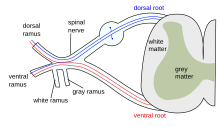Lower motor neuron lesion
This article needs additional citations for verification. (October 2019) |
| Lower motor neuron lesion | |
|---|---|
 | |
| Lower motor neuron in red |
A lower motor neuron lesion is a
One major characteristic used to identify a lower motor neuron lesion is
spastic paralysis – paralysis accompanied by severe hypertonia
.
Signs and symptoms
- Muscle paresis or paralysis
- Fibrillations
- Fasciculations– caused by increased receptor concentration on muscles to compensate for lack of innervation.
- atonia– Tone is not velocity dependent.
- Hyporeflexia - Along with deep reflexes even cutaneous reflexes are also decreased or absent.
- Strength – weakness is limited to segmental or focal pattern, Root innervated pattern[clarification needed]
The extensor
innervated
by the damaged nerves will be symptomatic.
Causes
The most common causes of lower motor neuron injuries are trauma to peripheral nerves that serve the axons, and viruses that selectively attack ventral horn cells. Disuse atrophy of the muscle occurs i.e., shrinkage of muscle fibre finally replaced by fibrous tissue (fibrous muscle) Other causes include
amyotrophic lateral sclerosis
.
Diagnosis
Differential diagnosis
- Myasthenia gravis – synaptic transmission at motor end-plate is impaired
- Amyotrophic lateral sclerosis– causes death of motor neurons, although exact cause is unknown it has been suggested that abnormal build-up of proteins proves toxic for the neurons.
See also
References
- ISBN 978-0-7817-7245-7. Retrieved 17 November 2010.
